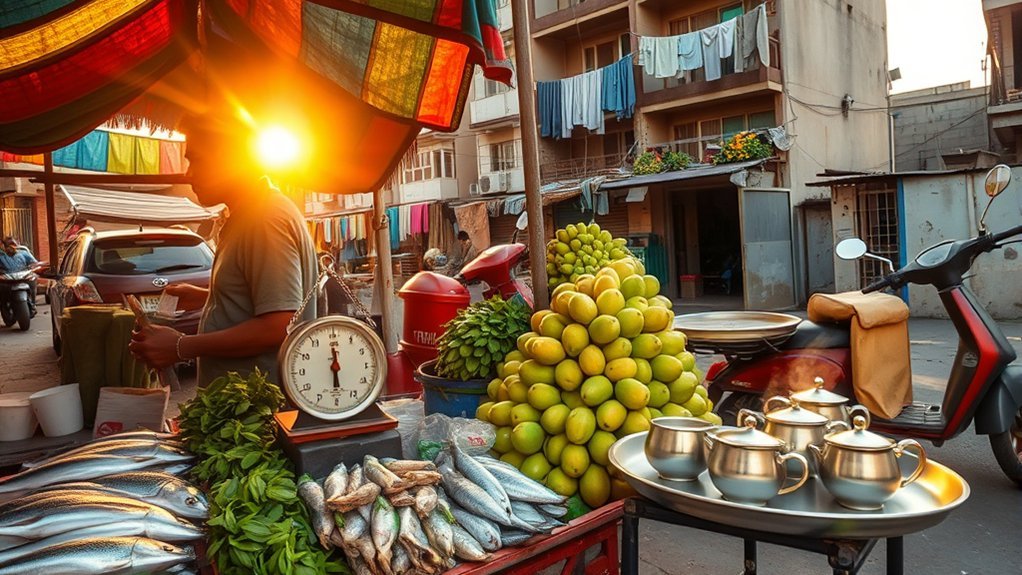You’ll need roughly $650–$720 a month to live in Myanmar’s cities, with Yangon nearer $700 and smaller towns cheaper. Rent dominates costs: a city-center one‑bed runs about $530, suburbs near $150. Food and transport are inexpensive (lunch ~$2, monthly transit ~$10), but private healthcare and international schools push budgets far higher. Utilities and internet add about $54 monthly. Keep this baseline in mind — read on for a detailed breakdown of where your money goes.
Overview of Living Costs and Key Statistics
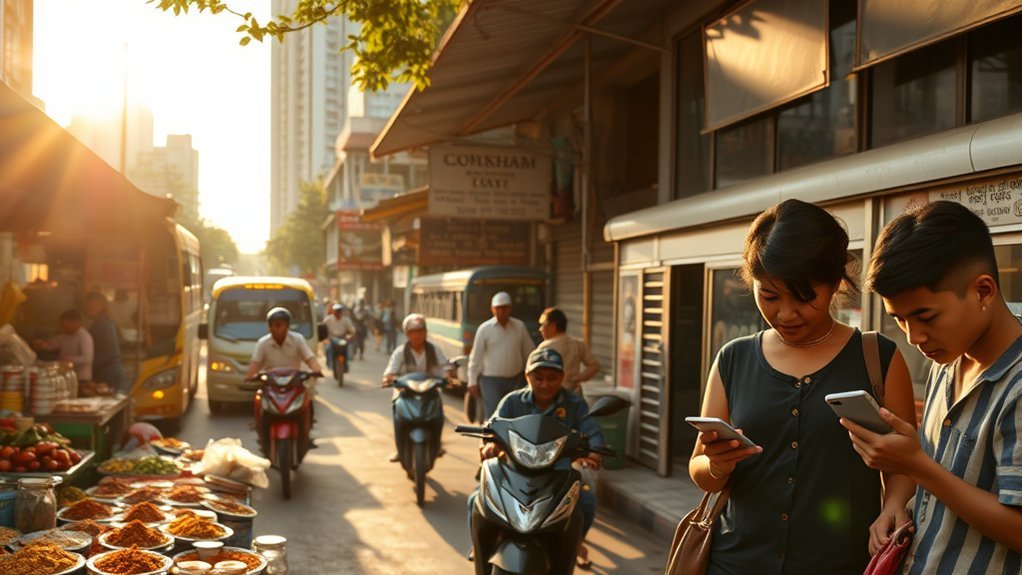
While Myanmar’s overall cost of living is relatively low, at about $658 per month—roughly 1.74 times cheaper than the world average and ranking 155th of 197 countries—you’ll see significant regional swings (Yangon ≈ $711; Mandalay ≈ $541).
You’ll find the cost of living driven by location, with Yangon about 31% pricier than Mandalay. Average post-tax salaries of roughly $278 mean your monthly income covers only about 0.4 months of basic expenses at the national average, so you’ll need supplemental income or savings.
Everyday spending looks affordable: a lunch menu averages $2.06 and a dinner for two runs about $16.60, both low versus global benchmarks.
Rental options vary widely—central one-bed units cost around $533 while budget one-beds can be $148—so your housing choices will disproportionately affect monthly totals.
When evaluating living in Myanmar, prioritize city-specific budgets and compare wages to regional cost-of-living differentials to plan realistically.
Housing and Rental Prices Across Cities
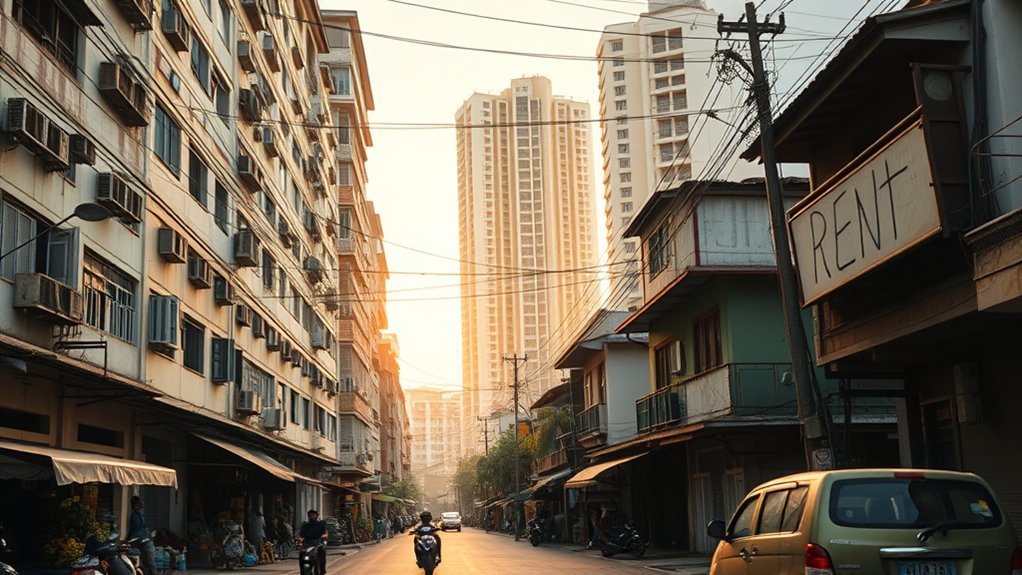
You’ll notice city-center rents—about $533 for a 1‑bed and $891 for a 3‑bed in Yangon—run substantially higher than suburb options like $148 for a basic 1‑bed, reflecting tradeoffs between safety/amenities in Bahan or Kamaryut and longer commutes from Hlaing or Thanlyin.
Furnished units typically command premiums and shorter vacancy periods compared with unfurnished flats, so compare monthly rates and expected move-in costs when budgeting.
Also factor in common lease terms and deposits (often one to three months’ rent) which materially affect upfront cash requirements.
City Center Vs Suburbs
Location matters: renting in Yangon’s city center will typically cost you far more than in the suburbs — a 1‑bed averages about $533 downtown versus roughly $148 outside, and a 3‑bed in central Yangon runs around $891, reflecting stronger demand in neighborhoods like Bahan and Kamaryut.
By contrast, outer districts such as Hlaing and Thanlyin offer lower rents, older buildings and fewer amenities, while newer urban developments command premiums for modern services.
You’ll pay a clear premium for centrality and perceived safety: rental prices rise where transport, retail and expat demand concentrate. Nay Pyi Taw shows rising rents too, signaling nationwide urban pressure.
If you prioritize cost, suburbs cut monthly housing expenses; if you want services, expect to pay for modern amenities.
Furnished Vs Unfurnished Rents
Because furnished units bundle utilities, appliances and often backup power, they command a clear premium: in Yangon a furnished 1‑bed in the center averages about $533 monthly versus roughly $148 for cheaper unfurnished options in outer areas.
When you compare furnished vs unfurnished rents, you’ll see central, high‑end furnished units push prices up due to demand, while mid‑range furnished properties keep steady occupancy.
Unfurnished units are the affordable choice if you can accept older buildings and potential issues like weak water pressure or no backup power.
Nay Pyi Taw rents are generally lower than Yangon’s but lack detailed unfurnished figures.
Your tradeoff is cost versus convenience: pay more for turnkey reliability or save substantially by taking an unfurnished place farther from the center.
Lease Terms and Deposits
After weighing the furnished-versus-unfurnished tradeoffs, you should also factor in lease terms and upfront costs that affect total monthly outlay: in Yangon landlords typically ask for one to three months’ rent as a security deposit.
So for a city-center one‑bed at ~$533 you’re likely to need $533–$1,599 cash up front, while cheaper outskirts units near $148 require only $148–$444.
Lease terms commonly run 6–12 months; shorter stays can incur higher monthly rates or additional deposits.
For larger units, a city-center three‑bed at ~$891 raises upfront needs to $891–$2,673.
Newer buildings demand higher rents and consequently larger security deposits, while older units reduce both monthly cost and deposit but may lack amenities.
Compare total locked capital when budgeting.
Food, Groceries and Eating Out
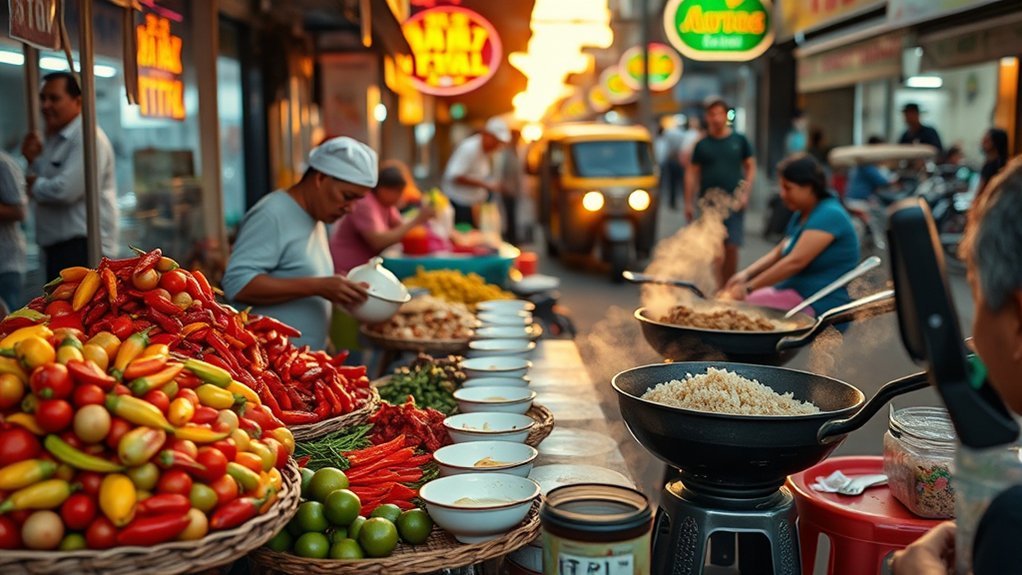
Though food in Myanmar stays generally inexpensive, you’ll see clear differences between street eats and mid-range dining: a typical lunch runs about $2.06, fast-food meals average $4.85, and a dinner for two at a mid-range restaurant is roughly $16.60. You’ll find groceries and eating out balance your budget—staples are cheap, restaurant choices range by price, and drinks are low-cost.
| Item | Typical Price | Notes |
|---|---|---|
| Lunch (street/menu) | $2.06 | Daily affordable option |
| Fast-food meal | $4.85 | International chains |
| Dinner for two | $16.60 | Mid-range restaurant |
| Beer (0.5L) / Cappuccino | $0.96 / $1.78 | Bar vs cafe |
Grocery examples reinforce value: 1L milk ≈ $1.60 and 0.5kg bread ≈ $0.90. If you prioritize local food and groceries, your monthly food spend stays low; if you prefer frequent mid-range dining or imports, costs rise noticeably.
Transportation and Connectivity
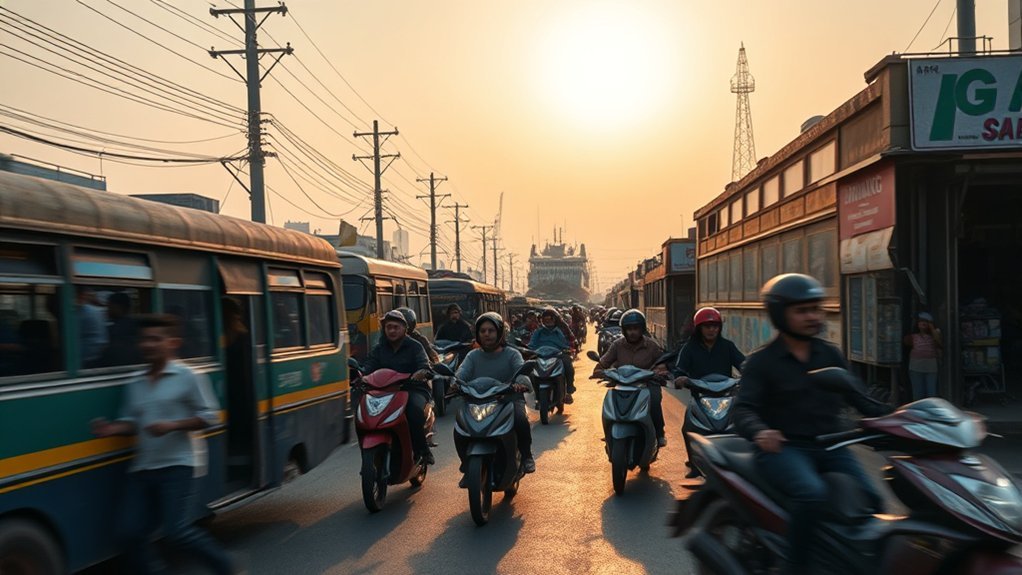
While public transit in Myanmar stays very cheap — single tickets run about $0.52 and a monthly pass is $9.79 — you’ll often weigh cost against reliability: buses are the cheapest option but can be inconsistent due to fuel shortages, taxis cost roughly $10.90 for an 8 km trip (and may run higher for foreigners), and the slow, frequently delayed rail network makes alternatives more attractive.
Public transit in Myanmar is very cheap, but expect reliability issues — buses and trains can be inconsistent, taxis cost more.
You’ll find transportation costs favorable compared with many regional capitals: a monthly pass at $9.79 undercuts urban averages, but service gaps push you toward taxis for punctuality.
If you’re expat living, budget for occasional higher taxi fares and negotiation. Use buses for routine travel to minimize expenses, reserve taxis when time matters, and treat rail journeys as low-cost but uncertain.
Factor in flexibility: cheap fares won’t guarantee timely connections, so plan buffer time and a slightly higher transport contingency in your monthly budget to absorb taxi surcharges and unexpected service disruptions.
Healthcare, Insurance and Medical Costs

Because Myanmar’s public system is chronically underfunded, you’ll likely pay out-of-pocket or rely on private hospitals that charge substantially more than public clinics but still often fall short of international standards.
Expect routine GP visits in private healthcare to cost several times public fees; a basic consultation can range from $10–$30, diagnostics and basic imaging add $20–$150, and inpatient care escalates quickly.
Complex cases frequently require evacuation: air ambulance and treatment abroad can exceed $50,000, so extensive health insurance with evacuation coverage is essential.
Insurance premiums vary widely—young, healthy expats might pay $1,000–$3,000 annually for decent international plans, while older or pre-existing conditions raise costs sharply.
Many locals can’t afford private services or extensive health insurance, creating access gaps.
When budgeting, compare plan coverage limits, evacuation caps, co-pays, and provider networks; skimping on insurance in Myanmar often produces far higher out-of-pocket liabilities.
Education and Schooling Options for Expats

If you’re relocating to Myanmar with children, expect to pay a premium for English-medium instruction: international school tuition commonly tops $10,000 per year and can climb much higher for secondary grades, while well-regarded bilingual or Montessori schools often charge less but still require significant fees and may have limited capacity.
You’ll find public schools underfunded and Burmese-medium, so they’re generally unsuitable if you need English instruction. International schools deliver curricula and language consistency but are the costliest option; budget at least $10k–$20k annually per child depending on grade and campus.
Emerging bilingual and Montessori schools offer lower tuition—often 30–60% of international-school rates—but availability is constrained and standards vary. Economic instability has pushed some expats toward homeschooling or local private schools as cost-saving alternatives.
Bilingual and Montessori options cost much less than international schools but are limited and quality can be uneven.
Don’t assume employer coverage: limited corporate support means you should negotiate school fee assistance into relocation packages or plan to absorb tuition in your housing/education budget.
Daily Life: Utilities, Internet and Services
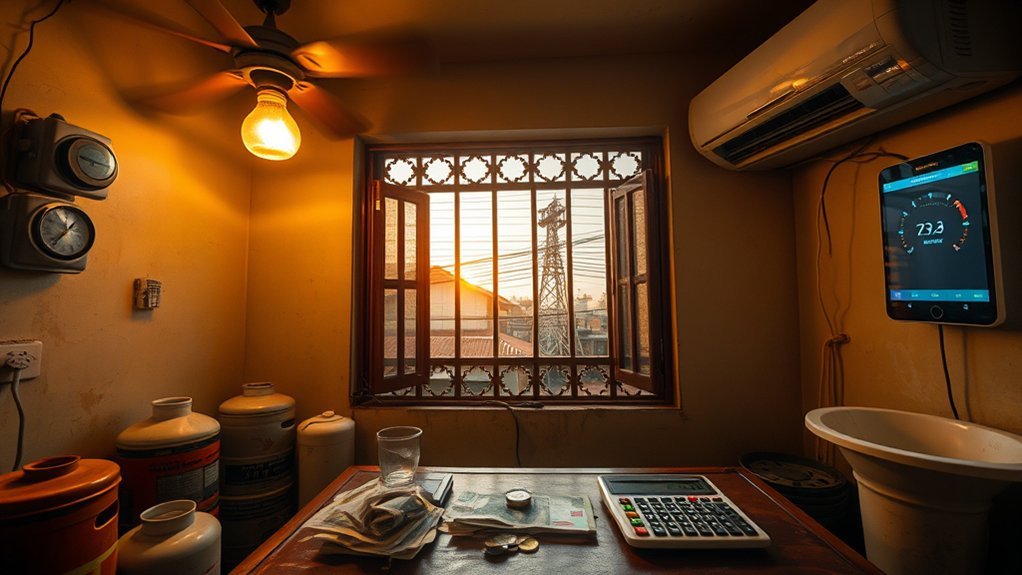
You’ll typically pay about $30.20 monthly for basic utilities (electricity, water, garbage) and around $23.60 for a 50+ Mbps internet plan, making combined essential services roughly $53.80 per month.
Expect occasional power outages and uneven water/garbage collection that can raise costs if you need backups or private services.
In cities, internet is broadly available but speeds and reliability vary by provider and neighborhood, so compare plans and factor in potential extra fees for maintenance or improved service.
Utilities: Bills and Costs
On average you’ll pay about $30.20 per month for basic utilities in Myanmar—electricity, water and heating—though urban apartments usually cost more and rural homes often face inconsistent supply that raises true expenses when backup generators or batteries are needed.
You’ll find utilities generally affordable compared with Western countries: the $30.20 baseline keeps living costs low for locals. Expect variance by region and accommodation type; city dwellers typically see higher bills due to consumption and metering, while rural residents may pay less but incur hidden costs from fuel for generators.
Budgeting should account for intermittent outages and occasional equipment or fuel purchases. Excluding internet, plan on roughly $25–50 monthly per person depending on usage patterns and reliability needs.
Internet: Speeds and Prices
Although urban areas like Yangon and Mandalay generally deliver better connections, expect spotty service outside major cities and plan accordingly: a 50+ Mbps plan averages about $23.60 per month, while mobile data packages—often cheaper—are common backups.
You’ll find internet in cities more reliable and faster than in small towns, where underdeveloped infrastructure causes inconsistency. If you need steady speeds for remote work, budget for the $23.60 fixed plan or combine it with affordable mobile data as redundancy.
Many people rely on café and public Wi-Fi, but speeds and uptime vary widely, so don’t assume consistency. Compare providers in your neighborhood for price versus advertised speed, and prioritize plans that balance cost, real-world throughput, and backup mobile affordability.
Services: Maintenance and Fees
Having covered internet costs and reliability, it helps to look at the wider monthly bills that shape your budget: utilities, maintenance and service fees together average about $30.20 per person for basic electricity, water and heating, while a 50+ Mbps internet plan adds roughly $23.60 and a local transport pass about $9.79.
You’ll find maintenance fees for serviced apartments vary widely; buildings with pools, gyms and 24/7 security can tack on noticeable monthly charges that push total housing costs above local averages.
Compare offerings: a low-fee unit keeps your cost base close to the $30 utilities figure, while premium amenities often double ancillary fees.
In rural areas, inconsistent utilities mean you may pay more for reliable private services.
Money, Safety and Practical Tips for Expats
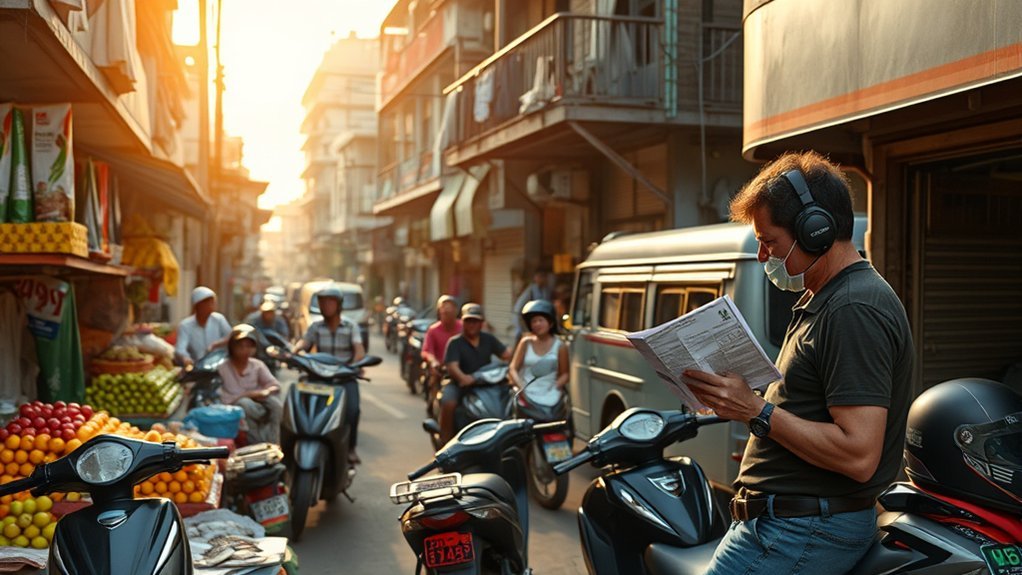
While Myanmar’s overall monthly cost of living averages about $658—roughly 1.74 times cheaper than the world average—you’ll find big variations in housing and services: a city-center one‑bed can cost anywhere from $148 (budget) to $533 (upscale), public buses are the cheapest but often unreliable, and private hospitals—more dependable than overcrowded public clinics—can drive your outlays much higher, so factor extensive health insurance and flexible transport budgets into your monthly planning. You should budget for international health coverage, set aside emergency cash, and prefer private clinics for serious care. Use taxis selectively; negotiate fares and keep small change for buses. For safety, avoid poorly lit areas, register with your embassy, and insure valuables. Compare rental locations: cheaper units can raise commuting costs. Track monthly spending against the national average to spot overruns.
| Item | Typical cost impact |
|---|---|
| Rent variance | $148–$533/month |
| Private healthcare | High, unpredictable |
| Public transport | Low cost, low reliability |
| Insurance | Essential for expats |
Frequently Asked Questions
Is It Expensive to Live in Myanmar?
Not really — you’ll find Myanmar much cheaper than global averages, with overall costs around $658 monthly; Yangon’s pricier ($711) and rent can spike, but food and transport stay very affordable compared to many countries.
Is Myanmar a Good Place to Live?
Like finding a bargain treasure, you might find Myanmar appealing if you want low costs; with average living at $658 versus higher wages elsewhere, you’ll compare city prices, healthcare gaps, and pay for private insurance accordingly.
What Is the Average Monthly Income in Myanmar?
The average monthly income in Myanmar is about $278 after taxes. You’ll notice it covers only roughly 0.4 months of typical expenses, making living costs comparatively low worldwide but still far above most locals’ earnings.
Is Myanmar Cheap or Expensive?
Myanmar’s overall living costs are cheap compared to many countries; you’ll pay about $658 monthly on average, rising in Yangon to ~$711, with expensive city rent but very affordable dining and basic expenses.
Conclusion
You’ll find Myanmar cheaper than many Southeast Asian hubs — rent, food and transport often run 30–60% below Bangkok or Kuala Lumpur — but costs vary by city and lifestyle. If you choose Yangon’s comfort, expect coincidentally higher utilities and international-school fees that push monthly expenses near regional averages; pick Mandalay or smaller towns and your budget drops accordingly. Plan with data, compare options, and budget for healthcare and visas to avoid surprises.

